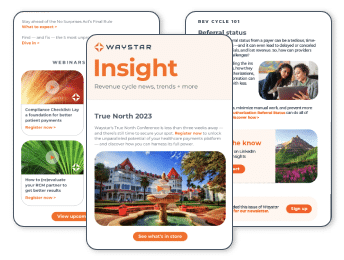Patient financial responsibility is not going away and is in a continuous state of rising year after year. Providers are responsible for effectively communicating and collecting self-pay and Balance After Insurance (BAI) balances in a patient-friendly way. Because patient satisfaction with the billing process is critical, we have identified some patient trends that we have been watching and how to be proactive.
High-Deductible Health Plans (HDHPs) are rising and rising
According to new U.S. National Data for 2017, the percentage of adults under the age of 65 who were in high-deductible plans rose again — from 39.4 percent in 2016 to 43.2 percent in 2017. This unprecedented rise in patient pay revenue is putting a challenging strain on hospitals and health systems. More and more resources are going into the collection process whether that be hiring more staff in-house or outsourcing the collection process to vendors. Utilizing a segmentation approach on what to keep in-house and what to outsource is key to utilizing resources effectively so that you aren’t using your most expensive resources on patients who just aren’t going to pay. This leads to our next trend.
Medical billing outsourcing is also growing at a fast rate
According to a report by Grand View Research, Inc., the medical billing outsourcing market was valued at $6.3 billion in 2015 and is anticipated to reach a value of $16.9 billion by 2024. More and more hospitals and health systems are outsourcing the accounts that have more complexity in collections. One way to determine this is through intelligent segmentation which leverages predictive analytics from bill drop through bad debt to gain insight into not only the ability but the willingness the patient will pay. Through this process, it is much easier to determine which accounts to keep in-house and which to send to an outsourced agency.
Patients are more scared of their medical bills than the actual diagnosis
A Kaiser Family Foundation/New York Times Medical Bills Survey showed that of adults aged from 18 to 64, 20% of insured and 53% of uninsured Americans struggled to pay medical bills in the past year. Patients are more afraid of receiving the medical bill than the actual diagnosis because of the rising costs of self-pay and how financially straining medical costs can be to an individual or family. Providing more upfront costs can help alleviate this burden. Reaching out to the patient pre-service about what will be owed, can make the collection process more successful since the patient won’t be surprised with the final bill. This also serves to improve patient satisfaction through transparency in the financial clearance process.
Patients are confused by their medical bills, now more than ever
According to another report, 72% of patients are confused by the explanation of benefits they receive from their health insurance plans and 70% are confused with their medical bills. This level of confusion leads to extreme dissatisfaction that is transferred to the provider unfortunately and not the insurance company. As mentioned above, reaching out to the patient pre-service to identify the costs upfront can alleviate this confusion and frustration. Another option is to use an insurance eligibility solution that tells the patient what will be covered by insurance and what will come out of their pocket.


